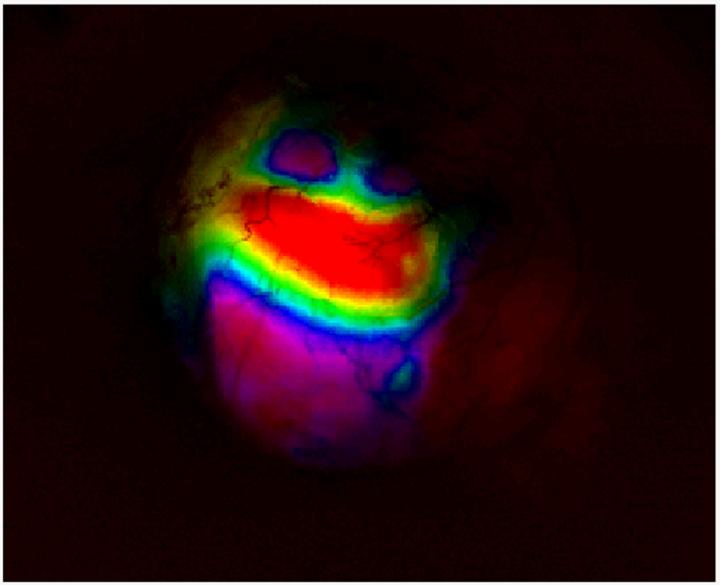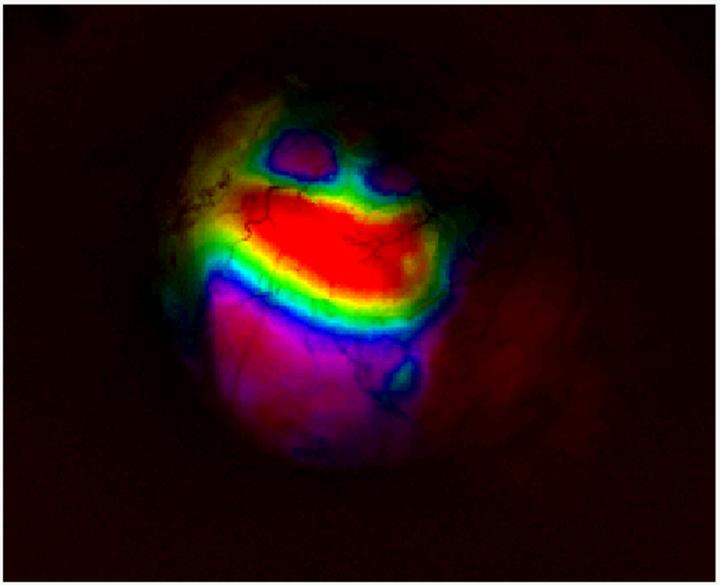
EUGENE, Ore. — University of Oregon scientists have looked into the brains of living mice to see in real time the processing of sensory information and generation of behavioral responses.
To do so, researchers developed a line of transgenic mice whose brains expressed a green fluorescent protein that lights up active neurons. They then used a customized wide-field microscope with dual lenses to capture images of the brain similar to what fMRI does in humans. Combined, the technique allows them to visualize the activity across cortex, the outer surface of the brain.
"This is like fMRI but with far greater temporal and spatial resolution, " said Cristopher M. Niell, a professor in the Department of Biology and member of the UO's Institute of Neuroscience. "We can visualize sensory inputs as they come into the brain, and the subsequent activity corresponding to a decision and behavioral response. We see the whole flow."
The wide-field imaging approach developed for the research provides a new tool that can serve as a bridge connecting human fMRI to live imaging of mice to explore the underlying mechanisms and genetics of brain function and development, said Niell and UO doctoral student Joseph B. Wekselblatt.
They are two of the four UO co-authors on a paper, which is now in press with the Journal of Neurophysiology.
Large-scale brain imaging is currently possible in smaller species, such as zebrafish and nematodes, but they lack cortex — the top layer of mammalian brains where cognition, memory, language learning and motor behaviors occur.
The visualization is possible because of the fluorescent protein, GCaMP6, which was developed by researchers at the Howard Hughes Medical Institute. The protein contains a calcium sensor and lights up when neurons are activated. The mouse line with GCaMP6 generated at the UO is being distributed to scientists around the world through a repository at Jackson Laboratory in Maine.
The transgenic mice can be followed throughout their lives, enabling the study of changes in brain function over extended periods of time, such as throughout the learning of a task. It also opens the possibility, Niell said, to explore brain issues associated with early development, adolescent behavior, schizophrenia and age-related deterioration of the brain.
Human brain studies done with fMRI, a specially developed use of magnetic resonance imaging, allows researchers to pinpoint specific regions of the brain that are active under certain conditions by measuring changes in the level of blood oxygen. It does not allow researchers to probe deeper to see specific neuronal circuitry occurring as tasks are performed.
The final step of the new mouse-imaging system involves two-photon imaging, which allows researchers to zoom in and see individual neurons that are active. Using the combination of wide-field and two-photon imaging, the researchers can study activity from the brain-wide global scale down to the local scale of groups of individual neurons.
"We deliver sensory inputs — moving images — that trigger decision-making by the mouse," Niell said. "As the inputs are registered and behavior begins, we can watch the flow of activity across the brain. You see it all in real time, and very quickly, nearly at the speed of thought."
"Our approach is faster than fMRI, where monitoring response is often measured in seconds," Wekselblatt said. "We see responses in a hundred milliseconds, and we can see the information flowing through cortex. You can't get that with fMRI. And then you can zoom in to see the circuitry behind the activation.
"In previous research, you'd have to use different animals at different times of their lives to get to information that you want," he said. "Here we can study the same mice over time to observe how patterns change when they are exposed to different variables, such as stress or medications."
By publishing their approach in the innovative methodology section of the Journal of Neurophysiology, the authors expect it will allow other researchers to use the approach in a wide range of studies of brain function, from sensory processing to cognition.
###
Co-authors with Niell and Wekselblatt are Erik D. Flister, a doctoral student, and Denise M. Piscopo, a staff scientist, both of Niell's lab.
The National Institutes of Health (grants T32 HD007348, F31 EY025459, DP2 EY023190 and RO1 EY023337) and the Searle Foundation supported the research.
Sources: Cris Niell, assistant professor of biology, 541-346-8598, [email protected], and Joseph Wekselblatt, doctoral researcher, [email protected]
Note: The UO is equipped with an on-campus television studio with a point-of-origin Vyvx connection, which provides broadcast-quality video to networks worldwide via fiber optic network. There also is video access to satellite uplink and audio access to an ISDN codec for broadcast-quality radio interviews.
Links:
Paper, early view abstract: http://jn.physiology.org/content/early/2016/02/19/jn.01056.2015
Niell faculty page: http://ion.uoregon.edu/content/cris-niell
Department of Biology: http://biology.uoregon.edu/
Institute of Neuroscience: http://ion.uoregon.edu/
UO Transgenic mouse facility: http://hgem.uoregon.edu/
Jackson Lab: https://www.jax.org/jax-mice-and-services
Media Contact
Jim Barlow
[email protected]
541-346-3481
@UOregonNews
http://uonews.uoregon.edu





